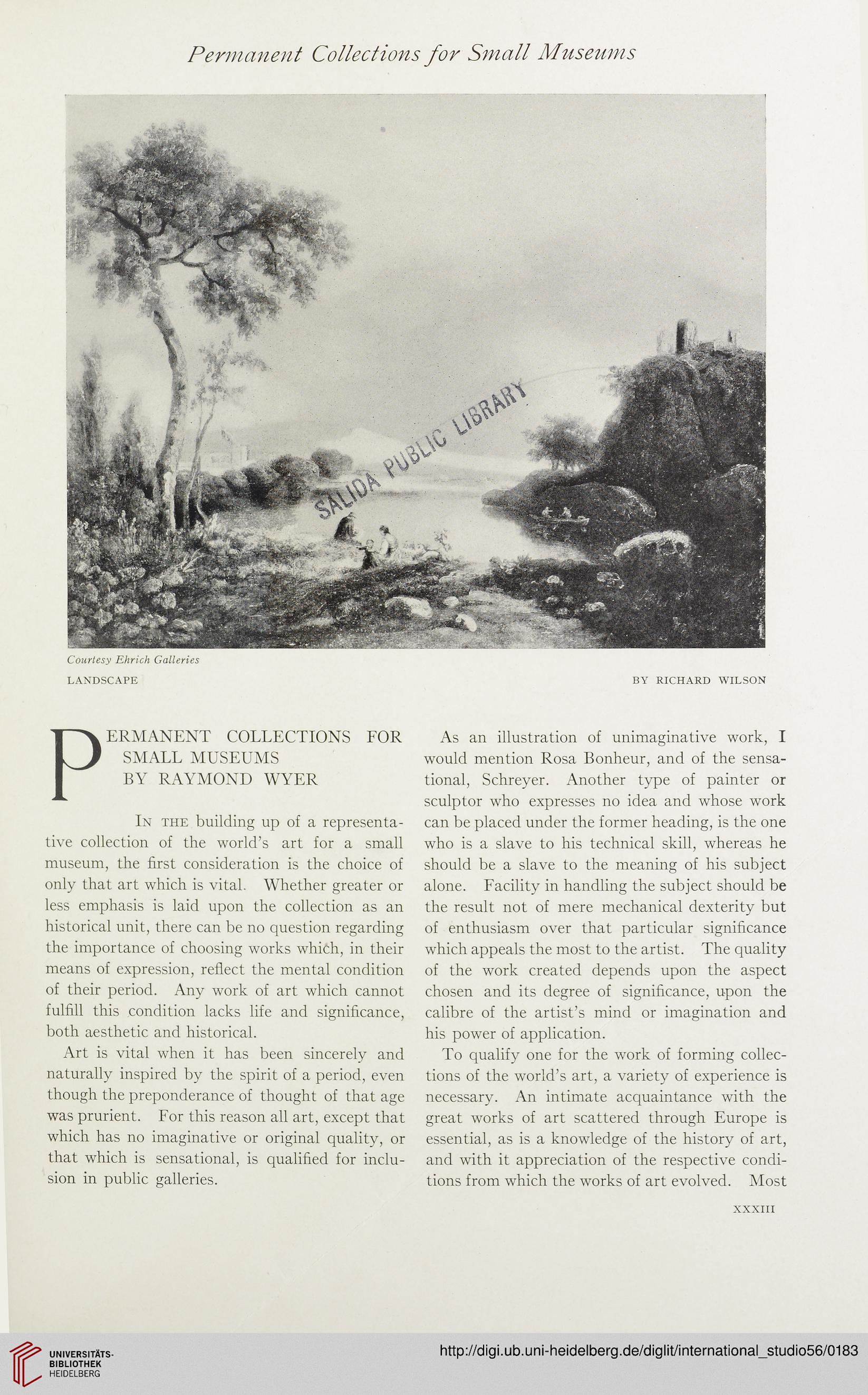Permanent Collections for Small Museums
Courtesy Ehrich Galleries
LANDSCAPE BY RICHARD WILSON
PERMANENT COLLECTIONS FOR
SMALL MUSEUMS
BY RAYMOND WYER
In the building up of a representa-
tive collection of the world’s art for a small
museum, the first consideration is the choice of
only that art which is vital. Whether greater or
less emphasis is laid upon the collection as an
historical unit, there can be no question regarding
the importance of choosing works which, in their
means of expression, reflect the mental condition
of their period. Any work of art which cannot
fulfill this condition lacks life and significance,
both aesthetic and historical.
Art is vital when it has been sincerely and
naturally inspired by the spirit of a period, even
though the preponderance of thought of that age
was prurient. For this reason all art, except that
which has no imaginative or original quality, or
that which is sensational, is qualified for inclu-
sion in public galleries.
As an illustration of unimaginative work, I
would mention Rosa Bonheur, and of the sensa-
tional, Schreyer. Another type of painter or
sculptor who expresses no idea and whose work
can be placed under the former heading, is the one
who is a slave to his technical skill, whereas he
should be a slave to the meaning of his subject
alone. Facility in handling the subject should be
the result not of mere mechanical dexterity but
of enthusiasm over that particular significance
which appeals the most to the artist. The quality
of the work created depends upon the aspect
chosen and its degree of significance, upon the
calibre of the artist’s mind or imagination and
his power of application.
To qualify one for the work of forming collec-
tions of the world’s art, a variety of experience is
necessary. An intimate acquaintance with the
great works of art scattered through Europe is
essential, as is a knowledge of the history of art,
and with it appreciation of the respective condi-
tions from which the works of art evolved. Most
XXXIII
Courtesy Ehrich Galleries
LANDSCAPE BY RICHARD WILSON
PERMANENT COLLECTIONS FOR
SMALL MUSEUMS
BY RAYMOND WYER
In the building up of a representa-
tive collection of the world’s art for a small
museum, the first consideration is the choice of
only that art which is vital. Whether greater or
less emphasis is laid upon the collection as an
historical unit, there can be no question regarding
the importance of choosing works which, in their
means of expression, reflect the mental condition
of their period. Any work of art which cannot
fulfill this condition lacks life and significance,
both aesthetic and historical.
Art is vital when it has been sincerely and
naturally inspired by the spirit of a period, even
though the preponderance of thought of that age
was prurient. For this reason all art, except that
which has no imaginative or original quality, or
that which is sensational, is qualified for inclu-
sion in public galleries.
As an illustration of unimaginative work, I
would mention Rosa Bonheur, and of the sensa-
tional, Schreyer. Another type of painter or
sculptor who expresses no idea and whose work
can be placed under the former heading, is the one
who is a slave to his technical skill, whereas he
should be a slave to the meaning of his subject
alone. Facility in handling the subject should be
the result not of mere mechanical dexterity but
of enthusiasm over that particular significance
which appeals the most to the artist. The quality
of the work created depends upon the aspect
chosen and its degree of significance, upon the
calibre of the artist’s mind or imagination and
his power of application.
To qualify one for the work of forming collec-
tions of the world’s art, a variety of experience is
necessary. An intimate acquaintance with the
great works of art scattered through Europe is
essential, as is a knowledge of the history of art,
and with it appreciation of the respective condi-
tions from which the works of art evolved. Most
XXXIII




